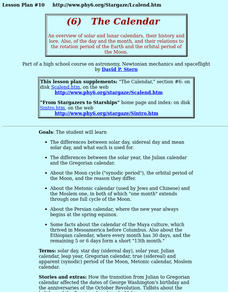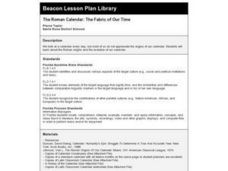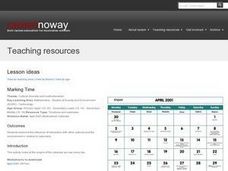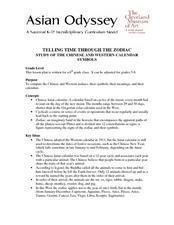Curated OER
The Calendar
Learners engage in an overview of solar and lunar calendars, their history and lore. Also, of the day and the month, and their relations to the rotation period of the Earth and the orbital period of the Moon.
Curated OER
The Roman Calendar: The Fabric of Our Time
Fourth graders explore the Roman origins and evolution of our calendar.
Curated OER
Making Moths
Young scholars study the Gregorian Calendar and its historical significance.In this calendar lesson students create a calendar design for an imaginary planet.
Curated OER
Leap Year
In this Leap Year reading comprehension worksheet, can learn about the various types of calendars (lunar, solar, etc.) and answer 7 multiple choice questions. Also included is a word search of key terms.
Curated OER
How Many Days Are in a Year?
Students create a calendar for an imaginary planet. For this earth science lesson, students analyze the errors on the different calendars used on Earth. They present their work in class.
Illustrative Mathematics
Comparing Years
Who knew that the Egyptian, Julian, and Gregorian year were different lengths? Your mathematicians will! They will have to calculate the difference between the years in seconds and find the percent change. Using dimensional analysis,...
Curated OER
Participants are challenged to create several different sorting groups for the set of images.
Students examine the influence of interaction with other cultures and the environment in relation to calendars. They also look at the origins of the calendar we use every day.
Curated OER
New Year Celebrations
Young scholars study the universality of many New Year celebrations. They present traditions associated with New Year celebrations and explain why New Year is at different times for different people.
Curated OER
The Achievements and Challenges of Guatemala
Students research the Mayan number and calendar system. They translate a variety of math problems from base-10 Arabic numbers into a base-20 Mayan representation. They discuss current challenges faced by the people in today's Guatemala.
Curated OER
Telling Time Through the Zodiac
Students compare the Chinese and Western zodiacs, their symbols, their meanings, and their calendars through a in-class discussion and a small group project. This lesson includes vocabulary and extensions.
Curated OER
Identifying Verb Tenses
How many different verb tenses are there? When do you use each? After introducing the different tenses with your upper elementary schoolers, have them read through a series of sentences, underline the verb in each sentence, and then...
Curated OER
New Year's Etymology and Writing Activity
Students investigate the history and etymology of New Year's Day. They listen to a teacher-led lecture about the background of New Year's Day, design an image of Janus, and write a story in the first person telling what Janus might say...
Curated OER
April Fool's Day
Students research how April Fool's Day began. They identify and discuss various theories, interview family members, write original myths about the first April Fool's Day and design a wild goose chase for another class.
Curated OER
Measurement and Estimation
Students gain an understanding of time. In this time lesson, students work together to recognize the difference between yesterday, today, and tomorrow, As well as months, hours, minutes, and seconds. Students brainstorm ideas of ways the...
Curated OER
Holidays: New Year's Eve/New Year's Day
In this foreign language worksheet, students read nine sentences about New Year's traditions. They are given two choices for each of the 13 blanks.














